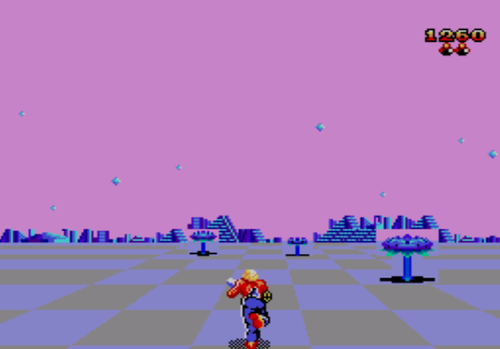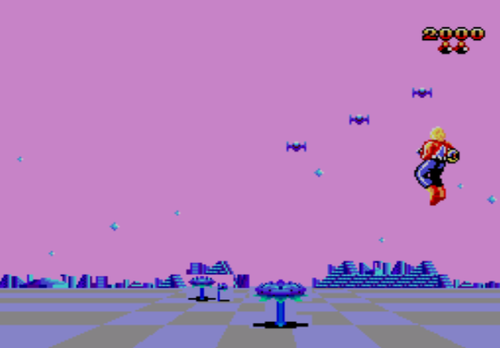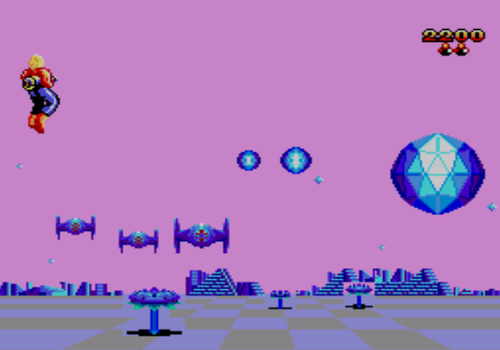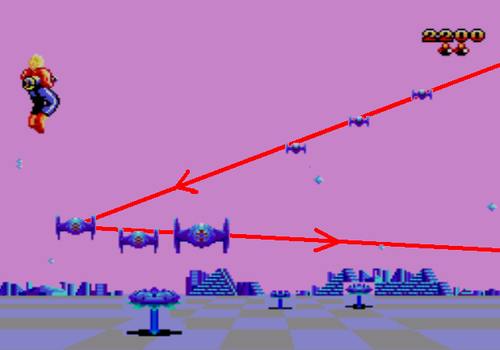vgthought.com
Tension in Space Harrier 3-D
Posted: 2014-02-28 01:30:48
Last edited: 2014-02-28 09:35:58
Originally posted here: Spiderduck Network
Last edited: 2014-02-28 09:35:58
Originally posted here: Spiderduck Network
I originally published this on Galactic Gaming News (which later became the Spiderduck Network) on August 20, 2012.
This article is light on analysis, but what's there is worthwhile. You'll get some basic insights on how to read a Space Harrier level, complete with a total rundown of the first stage of Space Harrier 3-D. This analysis leaves out more abstract concepts like theme and progression. But hey, even breaking up the level into segments called "feet" is an act of analysis, right?
This article assumes that the three Space Harrier games (Space Harrier, Space Harrier 3-D, and Space Harrier II) follow the same basic design sensibilities. By my experience, that's true, but the proof of that is beyond the scope of this article.
This article is light on analysis, but what's there is worthwhile. You'll get some basic insights on how to read a Space Harrier level, complete with a total rundown of the first stage of Space Harrier 3-D. This analysis leaves out more abstract concepts like theme and progression. But hey, even breaking up the level into segments called "feet" is an act of analysis, right?
This article assumes that the three Space Harrier games (Space Harrier, Space Harrier 3-D, and Space Harrier II) follow the same basic design sensibilities. By my experience, that's true, but the proof of that is beyond the scope of this article.
Games discussed:
Space Harrier 3-D
In just about all forms of entertainment, tension is a balance of determinate and random elements.
Like when you go to see a horror movie. You expect the axe murderer to kill someone; that much is predictable, or determinate. However, you cannot predict who gets killed and when it happens--there is an aspect of the random to it. If one of these elements was missing, there would be no tension. First, if you didnít expect the axe murderer to murder anyone, then youíd have no reason to worry. Second, if you knew who would die when, then the movie would be spoiled for you. There would be no suspense.
Space Harrier games make a clean split between the predictable and unpredictable elements.
Usually, these two elements of tension come from the same source. For instance, in the above example, the axe murdererís actions are the source of both the random and determinate aspects of tension. In Space Harrier, the predictable elements and the unpredictable elements belong to different entities.
(Which is not to say that this approach is unique to Space Harrier.)
Letís take a look at the start of Platia, the first stage of Space Harrier 3-D. If youíre into poetry, this will be the first line of Platia, and if youíre into music, it will be the first bar. Basically, itís the first unit that forms some kind of structure, but it isnít a complete thought.
Anyway, the first line of Platia has three feet. For simplicity, Iíll refer to each segment of a line as a foot. (Regarding the concept of feet, see the note at the bottom of Frames and Themes in Super Mario World.)
The first foot looks like this:

You run forward through a series of randomly placed blossoms (those blue flowerish things). The blossoms are not genuinely randomly placed; theyíll be in the same place every time you play the game. However, there is no pattern to their placement. Predicting each blossomís position before itís visible involves memorizing the placement of each individual object. Like all randomly placed objects in Space Harrier games, the blossoms are stationary. Also, if you run into a blossom, youíll die.
To continue the comparison to poetry, each individual blossom is a syllable of the first foot.
The second foot introduces the flyers (not fliers), a determinate element.

You can see them enter the screen hereótheyíre the TIE fighters at the top right. They swoop in from there, then...

...they switch gears and fly towards the foreground. They also shoot those blue spheres at your current position.
As you can see, they never break formation; they always follow one right after the other. On the other hand, what you probably canít tell is that this path is very predictable. Iíll combine the before and after pictures.

The red line indicates their direction. Flyers always take this elbow flight path. Because itís a predictable and simple path, itís easy to learn where to place Harrier (the guy you control in this game) to shoot them down. Plus, because all three fly in a line, once you shoot down the first one, itís easy to stay in one spot and shoot them all down.
For example, if you planted yourself at the joint of the elbow (the far left point of the red line), you could sit in place and continually press the shoot button while you wait for all of the flyers to cruise into your line of fire.
Note that there are still blossoms on the ground. This is how Space Harrier games create tension.
When you see a formation of flyers, itís not hard to find a good place to stay in order to shoot them all down. You know how theyíll behave. However, you canít predict where the blossoms will be placed. Remember, you die if you hit a blossom. So, what if youíre camped in a good spot to shoot down the flyers, when all of a sudden a blossom blocks your spot? Youíll have to improvise.
The flyers take a determinate path, so itís easy to create a plan to deal with them. However, blossoms are indeterminate, so they possess the ability to dash your plans. You can plan to occupy one spot in order to dispatch the flyers, only to have that spot stolen by a blossom.
Each individual blossom and each individual flyer is a syllable. So, the second foot is composed of contrasting syllables. You could say that the tension of the second foot comes from the difference between these types of syllables, the determinate flyers and indeterminate blossoms.
The third (and last) foot of the first line has a similar design. Youíll face blossoms and a formation of three flyers.
This approach to tension grants Space Harrier games a sense of speed, since youíll never be focused on one obstacle for very long; the enemies enter the screen and leave it in short order while tons of stationary objects whiz by. However, an element of strategy remains, since you can plan for dealing with enemies that fly in formations.
Most other rail shooters tend farther towards strategy than Space Harrier. For instance, Star Fox keeps your interest with complex enemy flight patterns and enemies that take multiple shots to down. Star Fox also has no answer for Space Harrierís randomly placed stationary objects. As a result, gameplay feels slower and more complex.
Games like Star Fox want to keep your focus. Youíve got to pay attention to enemies and follow the subtleties of their movements in order to make it through.
Space Harrier games are all about shaking your focus. You may want to focus on enemy flight patterns, but the randomly placed stationary obstacles will distract you. In Space Harrier, youíll need to focus on enemies, but that focus will need to be tempered by paying attention to the random objects, as well.
The overall structure of Platia is interesting, and it goes a decent ways to flesh out the interactions between determinate and indeterminate obstacles. If you would like to see it in motion, you can watch a video of it here.
Iíve also taken notes on each line of the stage so that itís easier to think about how the stage is structured. Iíll leave them here for you, accompanied by timestamps matching the video. The foot markings are my personal choice, but the timestamps are of course objective.
Line 1
- Foot 1: Blossoms: 0:24
- Foot 2: Blossoms: 0:31
- + 3 Flyers - background right -> left -> foreground right: 0:32
- Foot 3: Blossoms: 0:43
- + 3 Flyers - background left -> right -> foreground left: 0:47
- Foot 1: Towers: 0:54
- Foot 2: Towers: 1:00
- + 3 Turbo Jets: 1:01
- + 3 Turbo Jets: 1:07
- + 3 Turbo Jets: 1:12
- Foot 1: Towers: 1:16
- Foot 2: Towers: 1:22
- + 3 Turbo Jets: 1:22
- + 3 Flyers - foreground left -> right -> background left: 1:30
- + 3 Flyers - foreground right -> left -> background right: 1:31
- Foot 3: Towers: 1:36
- + 3 flyers - background left -> right -> foreground left: 1:45
- + 3 flyers - background right -> left -> foreground right: 1:45
- Foot 1: Blossoms: 1:51
- +3 Flyers - foreground right -> left -> background right: 1:52
- +3 Flyers - foreground left -> right -> background left: 2:01
- Foot 2: Towers: 2:05
- +3 Turbo Jets: 2:12
comments powered by Disqus
All original content on VG Thought was written by Greg Livingston AKA Golem.